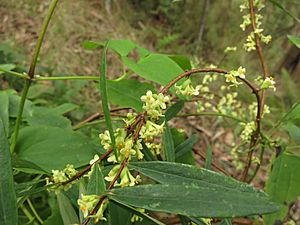Bootlace bush facts for kids
Quick facts for kids Bootlace bush |
|
|---|---|
 |
|
| Pimelea axiflora | |
| Scientific classification | |
| Genus: |
Pimelea
|
| Species: |
axiflora
|
The Bootlace Bush, also known as Pimelea axiflora, is a small shrub found only in Australia. It belongs to the Thymelaeaceae plant family. This plant usually has smooth stems and pretty whitish flowers.
Contents
What Does the Bootlace Bush Look Like?
The Bootlace Bush is a small shrub that can grow from about 20 centimeters (8 inches) to 3 meters (10 feet) tall. Its stems are usually smooth, but sometimes they can be a bit hairy.
Leaves and Flowers
The leaves of the Bootlace Bush grow in pairs opposite each other. They are often long and thin, or slightly oval-shaped. The top of the leaves is a medium green, and the underside is a lighter color. They can be from 5 to 60 millimeters (0.2 to 2.4 inches) long and 2 to 10 millimeters (0.08 to 0.4 inches) wide. Each leaf has a small stalk about 3 millimeters (0.1 inches) long. The edges of the leaves are usually curled under.
The flowers are white and grow in small groups of 2 to 10 flowers. These clusters appear where the leaves meet the stem, and they have very short or no stalks. Male flowers are a bit larger, about 5 to 9 millimeters (0.2 to 0.35 inches) long. Female flowers are smaller, about 3 to 6 millimeters (0.1 to 0.2 inches) long. There are usually 2 to 4 oval-shaped leaves called bracts near the flowers. These bracts are about 1.5 to 7 millimeters (0.06 to 0.28 inches) long. After flowering, the plant produces small green fruits, about 3 to 4 millimeters (0.1 to 0.16 inches) long.
Different Types of Bootlace Bush
Scientists have identified three main types, or subspecies, of the Bootlace Bush. They are all slightly different in how they look and where they grow.
P. axiflora subsp. axiflora
This type of Bootlace Bush has soft leaves that are 10 to 75 millimeters (0.4 to 3 inches) long. Its flowers are often covered with tiny hairs on the outside, especially near the stalk. The bracts (small leaves near the flowers) are also usually hairy on the outside. This subspecies flowers from June to December.
Where it Grows
You can find this subspecies in Tasmania, but only on King Island. In New South Wales, it grows along the coast and in the mountain ranges. It is found south of the Budawang National Park and near Braidwood. It is rare in the Snowy Mountains. This type of Bootlace Bush likes wetter places, often growing under eucalyptus trees or near streams.
P. axiflora subsp. alpina (Alpine Bootlace Bush)
This subspecies is known as the alpine bootlace bush because it grows in high, mountainous areas. It is a small shrub, usually less than 1 meter (3 feet) tall, and sometimes it grows flat along the ground. Its stems are smooth. The leaves are smooth, straight, and feel leathery. They are smaller, about 3 to 18 millimeters (0.1 to 0.7 inches) long.
Where it Grows
This alpine type grows at higher altitudes in the Snowy Mountains. It can be found in open areas with small shrubs, rocky spots, woodlands, and grassy fields. It flowers from November to March.
P. axiflora subsp. pubescens (Bungonia Rice-flower)
This subspecies is called the Bungonia rice-flower. It can grow up to 3 meters (10 feet) tall. Its stems can be smooth or hairy, especially when they are new. The underside of its leaves is hairy, and the leaves are 5 to 60 millimeters (0.2 to 2.4 inches) long. The top of the leaves is usually smooth.
Where it Grows
This type of Bootlace Bush flowers in September. It is only found in the Bungonia National Park in New South Wales. It grows on rocky, limestone cliffs and outcrops in this area.
Where Does the Bootlace Bush Live?
The Bootlace Bush grows in different parts of Australia. You can find it in the higher parts of the Grampian Mountains in Victoria. It also grows along the east coast of Victoria and in southeastern New South Wales. It is also found on King Island in Tasmania.
Protecting the Bootlace Bush
Some types of the Bootlace Bush are in danger and need our help to survive.
- The P. axiflora subsp. axiflora is listed as "endangered" in Tasmania. This means there are not many of these plants left, and they are at risk of disappearing.
- The P. axiflora subsp. alpina is considered rare in Victoria.
- The P. axiflora subsp. pubescens is also listed as "endangered". This is because there is only one known group of these plants, and it has a very small number of mature plants.

